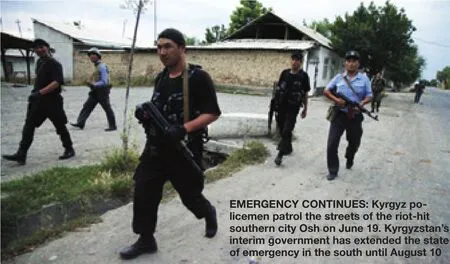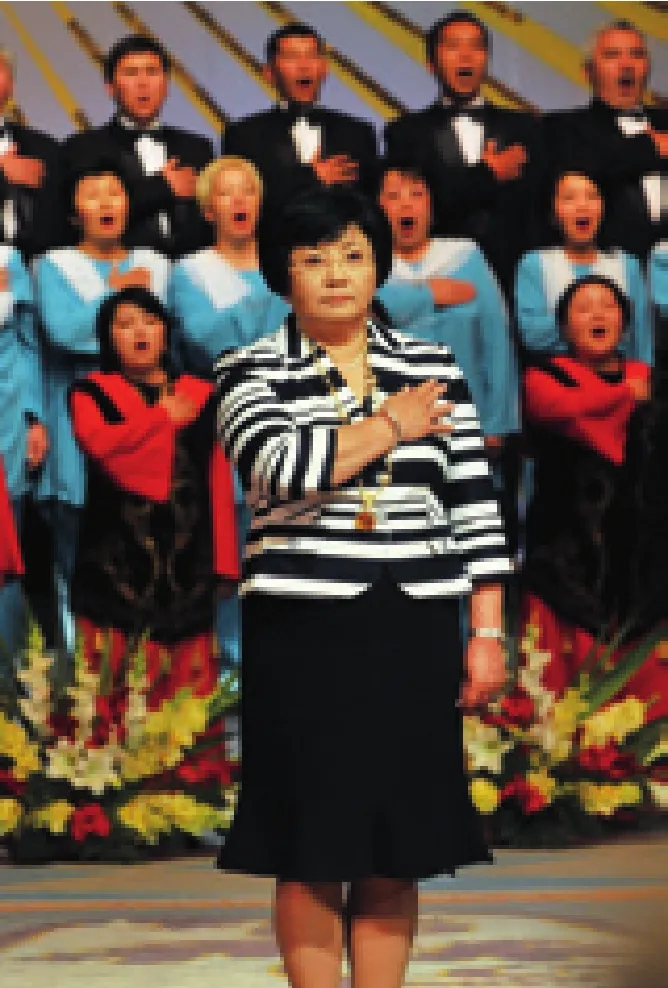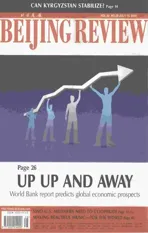Vote Points to Kyrgyzstan’s Future
2010-10-14ByLIUGUILING
By LIU GUILING
Vote Points to Kyrgyzstan’s Future
By LIU GUILING
Approval of a new Constitution is expected to bring stability to Kyrgyzstan
On June 27, a constitutional referendum was held in Kyrgyzstan.The Central Election Commission announced two days later a new Constitution had been approved.
Some 2.72 million people were eligible to vote and the turnout was more than 70 percent. Of those who cast ballots, some 90 percent voted for the new Constitution and only 8 percent voted against it.
The referendum partly solved the dispute about the legitimacy of Kyrgyzstan’s interim government led by Roza Otunbayeva. She was sworn in as Kyrgyzstan’s caretaker president on July 3.
After former President Kurmanbek Bakiyev was ousted in early April, a government headed by Otunbayeva took control.The interim government decided to hold a constitutional referendum on June 27 and parliamentary elections on October 10. The purpose of its calling for a revision of the Constitution was to eliminate despotism, patriarchal rule and corruption.
The core of the new Constitution is to convert Kyrgyzstan from a presidential system to a parliamentary republic. Under the new Constitution, Kyrgyzstan will establish a parliamentary system, which diminishes the president’s power and substantially increases parliamentary power.
To ensure a smooth referendum, the interim government took strict security measures. On June 27, more than 8,000 policemen, 7,500 volunteers and nearly 2,000 soldiers were sent to guard the more than 2,300 polling stations.
In the capital city Bishkek, and the Chui region where it is situated, 20,000 soldiers were deployed.
The referendum was to decide two issues:whether to approve the new Constitution and whether to agree with Otunbayeva’s serving as Kyrgyzstan’s president for a transitional period until the end of 2011.
Under the interim government’s wellorganized security measures and strong media campaign, the Kyrgyz people turned out in large numbers to vote. The 70-percent turnout was far above everybody’s expectations.

On June 27, Otunbayeva—in the riot-hit southern city of Osh, the second largest city in Kyrgyzstan—said some people claimed the country had collapsed, but the success of the referendum had proven a strong counter.
After her inauguration, Otunbayeva will strengthen control over the domestic situation. Before the parliamentary elections in October, she will be both head of state and of the government, shouldering the responsibility of stabilizing the domestic situation and restoring the economy.
Parliamentary elections, in line with new constitutional provisions, will be held every five years. The president enjoys a six-year presidential term and is not allowed to serve a further term.
Otunbayeva’s swearing in as president satisfied the public’s desire to establish a legitimate government in Kyrgyzstan as quickly as possible.
Since April, Kyrgyzstan has been in political and social unrest. Otunbayeva’s interim government set in place a series of measures to maintain stability. The causes of the riots were investigated and perpetrators were punished. Meanwhile,arrangements were made for refugees to come back to Kyrgyzstan. So far, a large number of refugees have returned to Osh and other areas in the south, where ethnic riots broke out. Further,the government is gradually rebuilding Osh and other riot-hit cities.
Intervention of external forces may make Kyrgyzstan’s social unrest worse
Otunbayeva said, at her swearing-in ceremony, the government’s most pressing task was to strengthen solidarity among different ethnic groups, restore social order and improve living standards. This shows the new government will further intensify its efforts and the country will hopefully recover from the tensions of recent months and start to build a stable government.
Challenges
Because of a poor economy and complex social problems, it will be dif fi cult for the new government to make achievements in the short term.
First, the parliamentary system is hard to implement.The revision by the interim government focused on changing the country’s political institution. Previously,most of the powers were in the hands of the president.But the new Constitution advocates transferring the country’s main decision-making power to the legislative branch. Judging from Kyrgyzstan’s national conditions, it will be hard for the parliamentary system to take root.
There are presently quite a number of political parties in Kyrgyzstan, but the political party system is very weak. Of about 150 political parties, only six or seven are relatively strong,with clear political programs and standing in the interim government. They will obtain seats in the future parliament as well.

XINHUA/AFP

TAKING THE OATH: Roza Otunbayeva,is sworn in as president for a transitional period until December 31, 2011, in Bishkek on July 3
But Kyrgyzstan lacks the external conditions and a social basis featuring Westernstyle democracy for the formation of a political party system. In the past fi ve years,all Kyrgyzstan’s legislative procedures, including referendums, have failed to resolve its internal problems.
In addition, it will be very difficult to establish a coalition government. The country’s parties mainly represent different regions and ethnic groups. They have no clear political proposals or long-term goals.As the interests of various regions are quite different, it will be hard to bring them to a uni fi ed viewpoint. The parliamentary system might therefore intensify political and ethnic con fl icts, and lead major political forces into endless attempts to grab power.
The second challenge for Otunbayeva is the poor economy. Kyrgyzstan is located in the hinterland of Central Asia. Scarce in resources and weak in economic foundation, it is one of the poorest countries in the Commonwealth of Independent States.
The poor economy and low living standards are the basic reasons for the multiple riots and change of governments. Since Bakiyev took power following the Tulip Revolution in 2005, the Kyrgyz economy has seen no improvement. Kyrgyzstan’s percapita GDP was only $870, about one 10th that of Kazakhstan. And people’s income increased quite slowly.
Things were even worse after the global financial crisis broke out in 2008. In 2009, its GDP dropped to about $4.6 billion, its currency depreciated by 30 percent, and the income of locals going abroad to work plummeted by 60 percent. Falling incomes, coupled with in fl ation,made people’s lives miserable.
In 2010, the government’s budget de fi cit hit $300 million. Since the beginning of this year, electricity prices have doubled and heating costs have risen by fi ve to 10 times.These resulted in many complaints from the Kyrgyz people.
After the interim government was set in place, it lowered water and electricity prices,increased policemen’s salaries and paid the salaries of civil servants on time. Through these measures, it won the support of a section of the people.
But ethnic riots in the south worsened the economic situation. The riots caused the departure of a large number of foreign businessmen as well as the fl ight of foreign investment and suspension of many cooperative projects. It will be hard for the Kyrgyz Government to overcome economic dif fi culties in the short term.
The third challenge is in maintaining stability. North-south conflicts and ethnic grievances form potential causes of Kyrgyzstan’s social unrest.
Former President Bakiyev was a representative of southern forces. When he was in of fi ce,northern forces were completely marginalized.This aroused complaints in the north for a long time. In the 2009 presidential election, Bakiyev generally obtained less than 50 percent of the vote in northern regions.
In March, the political opposition instigated a large-scale riot, which spread nationwide. By April 8, the interim government had gradually brought most of the regions to order. The state’s security apparatus started to work again and social order was restored.Bakiyev fl ed abroad.
But, from June 10-14, a massive ethnic riot broke out in the south of Kyrgyzstan, in which nearly 270 people were killed. Hundreds of thousands of refugees fl ed to Uzbekistan. The situation was almost out of control.
In a word, the time bomb of deeply rooted regional and ethnic conflicts in Kyrgyzstan went off.
Kyrgyzstan’s military and police forces have long been weak. Poorly equipped and with low training levels, they are not capable enough of maintaining social stability.
Although the situation in the south is easing, Otunbayeva on June 27 extended the state of emergency in the south to August 10.
Intervention of external forces may make Kyrgyzstan’s social unrest worse. During the riots, a large number of weapons fell into the hands of terrorists. In addition to the rampant activities of terrorism, separatism and extremism in the south, grassroots political power is weak, so it is difficult for the government to effectively control the region—especially the Fergana Valley, where Kyrgyzstan, Uzbekistan and Tajikistan border on each other. It is the weakest point of Central Asian security. And it holds great potential to threaten Kyrgyzstan’s future social stability.
Another challenge for Otunbayeva is in the rebuilding of infrastructure and restoring of production. It is a pressing task for the Kyrgyz Government to restore production and improve people’s livelihoods. But the destruction caused by the riots has increased the cost of reconstruction. In addition, the government is lacking funds, making the situation quite dif fi cult for Otunbayeva.
How to ease ethnic conflicts is also a headache for Otunbayeva. While meeting local NGO representatives after attending the referendum, she said the government needed to rely on“citizen diplomats” to solve the Uzbek-Kyrgyz ethnic conflicts. She promised to solve the housing and schooling problems of the returned refugees before winter. But, given the state of the national treasury, keeping this promise will be a severe test.
External factors
The new government is also faced with grave challenges in international relations. It still has to fi nd a balance between the United States and Russia.
Kyrgyzstan is an area of interest for various international forces, especially the United States and Russia. Russia has traditional interests in Kyrgyzstan and the United States regards Kyrgyzstan as an important transit center for its war in Afghanistan since the country offered it an air base at the Manas Airport near Bishkek.
Both the United States and Russia want to expand their influence in Kyrgyzstan.Currently, U.S.-Russian relations are improving and the two countries have reached a good understanding in discussions of the Kyrgyz situation.
In late June, Russian President Dmitry Medvedev paid a visit to the United States.The two sides increased coordination on the Kyrgyz issue. Presidents Medvedev and Barack Obama also issued a joint declaration on the Kyrgyz situation.
But Central Asia is Russia’s sphere of infl uence. Russia does not want external forces to intervene.
Although the United States played down the issue of the air base at Manas after the overthrow of former President Bakiyev and sent out signals of cooperation during Medvedev’s visit, it will not easily concede on the air base issue.
Russia was not satisfied. Medvedev said, before the visit, the U.S. military base in Kyrgyzstan should not remain in the long term.
The author is a research fellow with the China Institutes of Contemporary International Relations
